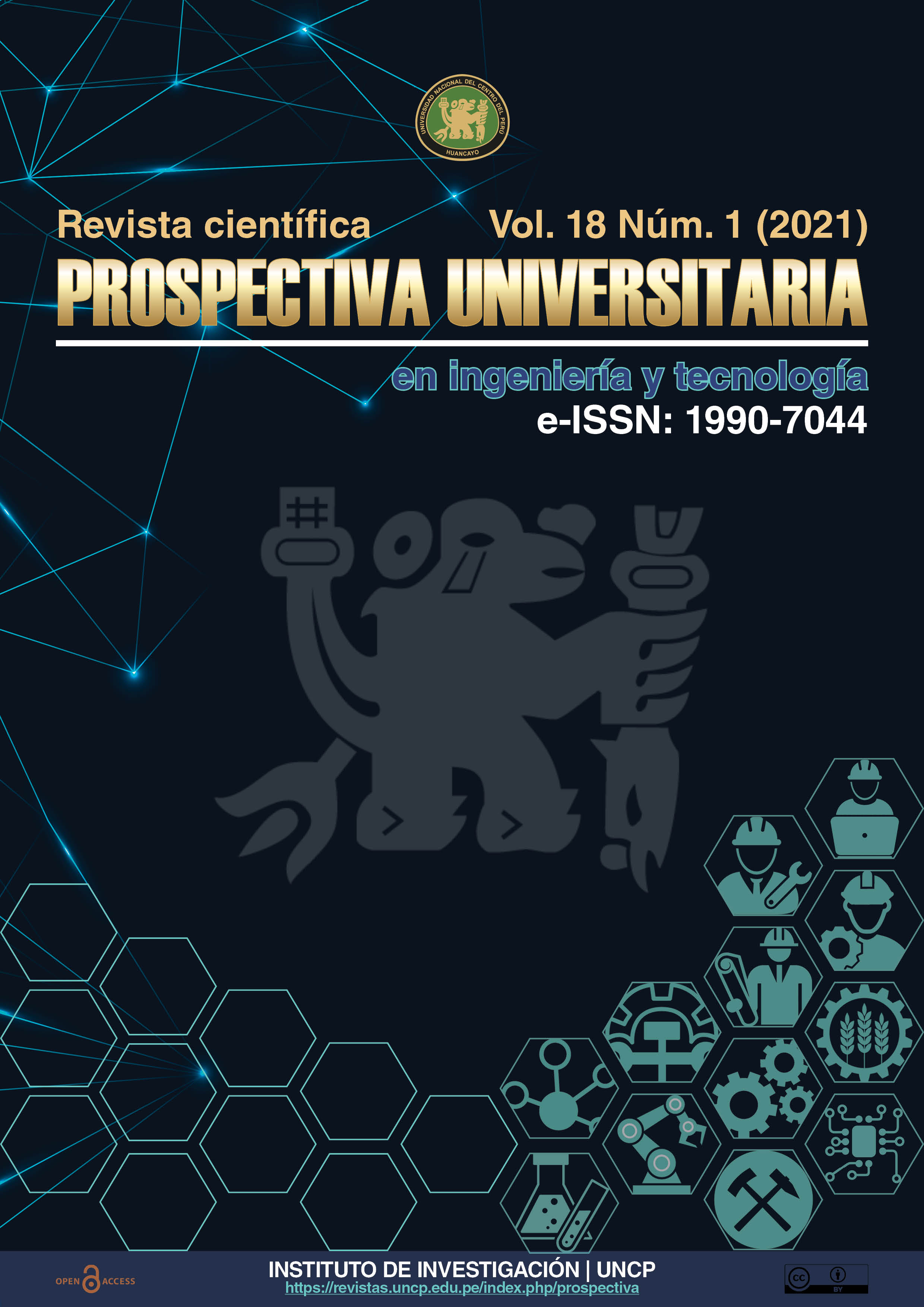Gradiente altitudinal de la radiación ultravioleta en la región Junín
DOI:
https://doi.org/10.26490/uncp.prospectivauniversitaria.2021.18.1415Palabras clave:
Gradiente altitudinal, Radiación, Capa de ozono, ClimatologíaResumen
El principal instrumento para evaluar el índice ultravioleta fue el modelo TUV para inferir el índice ultravioleta, debido a interacciones con otros gases (ozono total) o partículas (aerosoles atmosféricos). Asimismo, se obtuvo que la intensidad de radiación ultravioleta en la región Junín es elevado (valores cercanos a 20), lo que puede producir enfermedades, como cáncer a la piel, si tenemos alto tiempo de exposición. También, el gradiente vertical se obtuvo valores cercanos a 2 de índice UV por cada 1 km de altitud.
Descargas
Referencias
ACIA. (2005). Arctic climate impact assessment. Scientific Report. Cambridge University Press,
Cabrera, S.; Ipiña, A.; Damiani, A.; Cordero, R. R. & Piacentini, R. D. (2012). UV index values and trends in Santiago, Chile (33.5°S) based on ground and satellite data. Journal of Photochemistry and Photobiology B: Biology, vol. 115, pp. 73-84. ISSN 10111344. DOI https://doi.org/10.1016/j.jphotobiol.2012.06.013
Cede, A.; Luccini, E.; Nuñez, L.; Piacentini, R. D. & Blumthaler, M. (2002). Monitoring of erythemal irradiance in the Argentine ultraviolet network. Journal of Geophysical Research Atmospheres, ISSN 01480227. DOI https://doi.org/10.1029/2001JD001206 .
Cede, A.; Luccini, E.; Nunez, L.; Piacentini, R. D.; Blumthaler, M. & Herman, J. R. (2004). TOMS-derived erythemal irradiance versus measurements at the stations of the Argentine UV Monitoring Network. Journal of Geophysical Research D: Atmospheres, ISSN 01480227. DOI https://doi.org/10.1029/2004JD004519 .
Cockell, C. S.; Scherer, K.; Horneck, G.; Rettberg, P.; Facius, R.; Gugg-Helminger, A.; Driscoll, C. & Lee, P. (2001). Exposure of arctic field scientists to ultraviolet radiation evaluated using personal dosimeters. Photochemistry and Photobiology, ISSN 0031-8655. DOI https://doi.org/10.1562/0031-8655(2001)074<0570:eoafst>2.0.co;2 .
De Gruijl, F. R., Longstreth, J., Norval, M., Cullen, A. P., Slaper, H., Kripke, M. L., Takizawa, Y. & Van Der Leun, J. C. (2003). Health effects from stratospheric ozone depletion and interactions with climate change. Photochemical and Photobiological Sciences, ISSN 14749092. DOI https://doi.org/10.1039/b211156j .
Foyo Moreno, I., Alados, I., Olmo, F. J. & Alados Arboledas, L. (2003). The influence of cloudiness on UV global irradiance (295-385 nm). Agricultural and Forest Meteorology. S.l.: s.n., DOI https://doi.org/10.1016/j.agrformet.2003.08.023 .
Krotkov, N. A.; Bhartia, P. K.; Herman, J. R.; Fioletov, V. & Kerr, J. (1998). Satellite estimation of spectral surface UV irradiance in the presence of tropospheric aerosols 1. Cloud-free case. Journal of Geophysical Research Atmospheres, ISSN 01480227. DOI https://doi.org/10.1029/98JD00233 .
Madronich, S. (1993). The atmosphere and UV-B radiation at ground level. Environmental UV Photobiology. S.l.: s.n.,
Mckenzie, R. l.; Seckmeyer, G.; Bais, A. f.; Kerr, J. B. & Madronich, S. (2001). Satellite retrievals of erythemal UV dose compared with ground-based measurements at northern and southern midlatitudes. Journal of Geophysical Research Atmospheres, ISSN 01480227. DOI https://doi.org/10.1029/2001JD000545 .
Parra, R.; Cadena, E. & Flores, C. (2019). Maximum UV index records (2010-2014) in Quito (Ecuador) and its trend inferred from remote sensing data (1979-2018). Atmosphere, vol. 10, no. 12, pp. 1-17. ISSN 20734433. DOI https://doi.org/10.3390/ATMOS10120787 .
Sordo, C. & Gutiérrez, C. (2013). Cáncer de piel y radiación solar: experiencia peruana en la prevención y detección temprana del cáncer de piel y melanoma. Revista Peruana de Medicina Experimental y Salud Pública, ISSN 1726-4634. DOI https://doi.org/10.1590/s1726-46342013000100021 .
Suárez Salas, L. F.; Flores Rojas, J. L.; Pereira Filho, A. J. & Karam, H. A. (2017). Ultraviolet solar radiation in the tropical central Andes (12.0 °S). Photochemical and Photobiological Sciences, ISSN 14749092. DOI https://doi.org/10.1039/c6pp00161k .
Tanskanen, A.; Krotkov, N. A.; Herman, J. R. & Arola, A. (2006). Surface ultraviolet irradiance from OMI. IEEE Transactions on Geoscience and Remote Sensing, ISSN 01962892. DOI https://doi.org/10.1109/TGRS.2005.862203 .
Thomas Gavelan, E.; Sáenz Anduaga, E.; Ramos, W.; Sánchez Saldaña, L. & Sialer, M. del C. (2011). Exposição solar e conhecimento, atitudes e práticas de fotoproteção em pacientes de unidades ambulatoriais de dermatologia em quatro hospitais de Lima, Peru. Anais Brasileiros de Dermatologia, ISSN 03650596. DOI https://doi.org/10.1590/S0365-05962011000600009 .
Instituto Geofísico del Perú. (2012). Eventos Meteorológicos extremos en el valle del Mantaro. http://www.met.igp.gob.pe/publicaciones/2012/maremexvol1.Pdf
Descargas
Publicado
Número
Sección
Licencia
Derechos de autor 2021 Roberto Angeles Vásquez

Esta obra está bajo una licencia internacional Creative Commons Atribución-NoComercial-CompartirIgual 4.0.
Esta Revista es de acceso abierto a su contenido a través del Internet, poniendo a disposición de la comunidad científica los resultados de la investigación, de manera gratuita, para el intercambio del conocimiento desarrollado.
El contenidos de la Revista se distribuyen bajo la licencia Creative Commons Reconocimiento-NoComercial-CompartirIgual 4.0 Internacional.
![IconJournalPU [ESP] by Edgar Julian-Laime®](https://revistas.uncp.edu.pe/public/journals/1/pageHeaderLogoImage_es.png)









